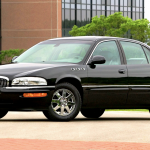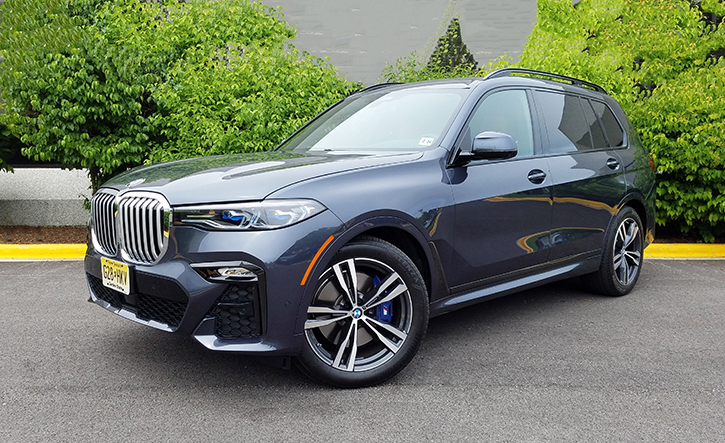
 2019 BMW X7 xDrive50i
2019 BMW X7 xDrive50i
Class: Premium Large Crossover
Miles driven: 333
Fuel used: 20.3 gallons
| CG Report Card | |
|---|---|
| Room and Comfort | B+ |
| Power and Performance | A- |
| Fit and Finish | A |
| Fuel Economy | C |
| Value | B- |
| Report-card grades are derived from a consensus of test-driver evaluations. All grades are versus other vehicles in the same class. Value grade is for specific trim level evaluated, and may not reflect Consumer Guide's impressions of the entire model lineup. | |
| Big & Tall Comfort | |
| Big Guy | A |
| Tall Guy | A |
| Big & Tall comfort ratings are for front seats only. "Big" rating based on male tester weighing approximately 350 pounds, "Tall" rating based on 6'6"-tall male tester. | |
| Drivetrain | |
| Engine Specs | 456-hp 4.4 liter |
| Engine Type | Turbocharged V8 |
| Transmission | 8-speed automatic |
| Drive Wheels | AWD |
Real-world fuel economy: 16.4 mpg
Driving mix: 60% city, 40% highway
EPA-estimated fuel economy: 15/21/17 (city/highway/combined)
Fuel type: Premium
Base price: $92,600 (not including $995 destination charge)
Options on test vehicle: Cold Weather Package ($1200), Dynamic Handling Package ($4750), M Sport Package ($3550), Premium Package ($1550), Executive Package ($2100), Display Key ($300), leather dashboard ($1200), second-row captain’s chairs ($600), Bowers & Wilkins premium audio system ($3400)
Price as tested: $112,245
Quick Hits
The great: Robust acceleration; high-class interior trimmings
The good: Passenger and cargo room; ride and handling
The not so good: Steep prices; some complicated controls
More BMW price and availability information
John Biel
The big news from BMW in 2019 is the X7, “the biggest BMW ever built” says, well, BMW.
With it, the German automaker joins the 3-row-SUV club, premium branch. At 203.3 inches end to end, it is nine inches longer than the brand’s midsize 2-row X5, and can seat as many as seven passengers or hold up to 90.4 cubic feet of cargo. All X7s come with standard xDrive all-wheel drive and an 8-speed automatic transmission, so the chief (but not the only) differentiator between the two available models is the engine.
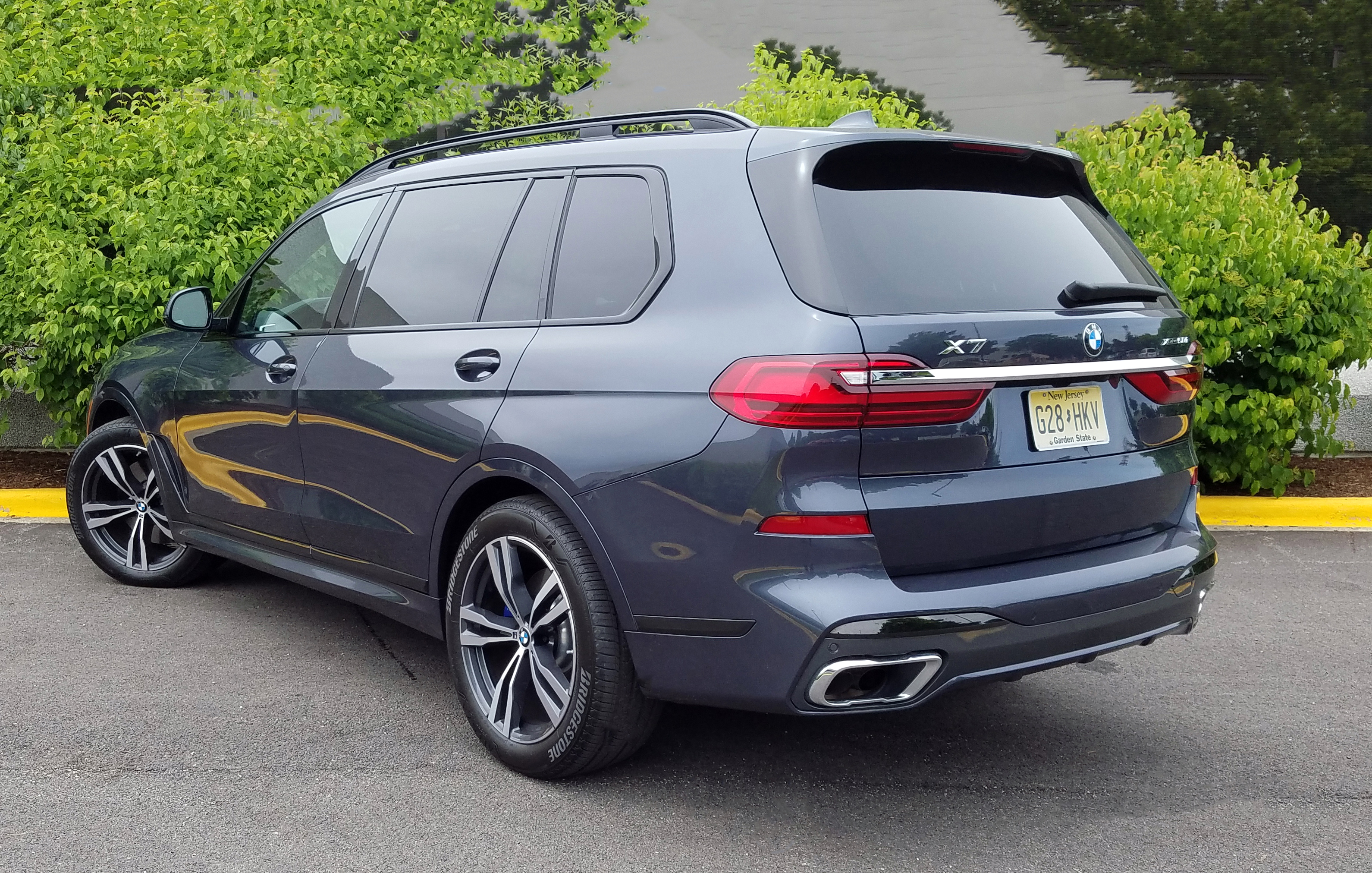
The xDrive40i, with a starting price of $74,895 including delivery, is powered by a 335-horsepower turbocharged 3.0-liter inline 6-cylinder powerplant. The xDrive50i, which leaves dealerships for no less than $93,595, is motivated by a 456-horse twin-turbo 4.4-liter V8. Consumer Guide editors sampled one of the latter for this report.
Test Drive: 2019 BMW X5 xDrive40i
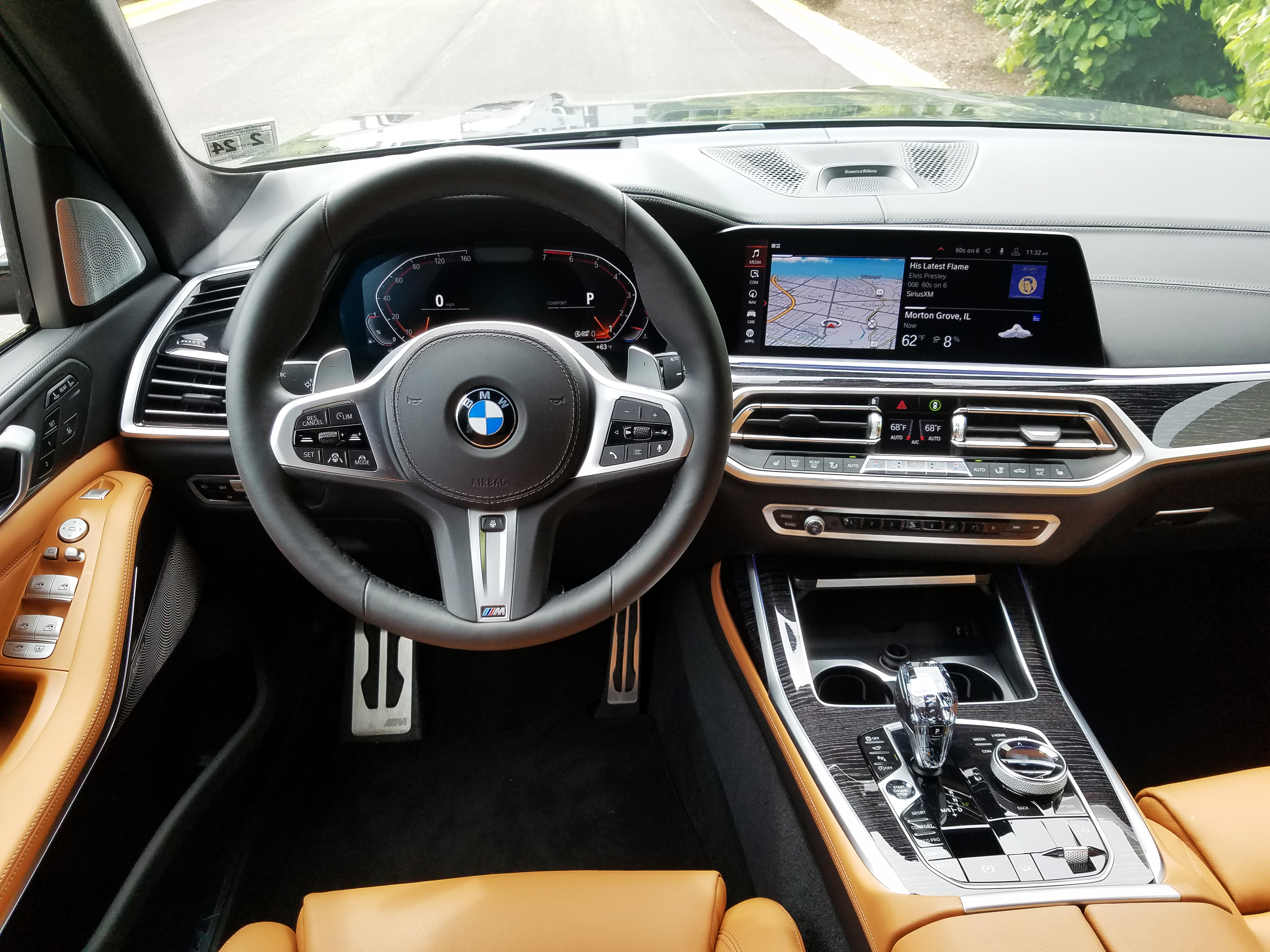
While a good many marques have been frantically filling up the subcompact and compact crossover fields in the last decade or so, some have been adding large 3-row jobs to make sure they’re getting as many licks as they can off the SUV ice cream cone. The X7 works moderately well as a people hauler. Its third-row seats power up from the floor and offer cushion height acceptable for adult seating—though legroom for grown-ups is tight and headroom isn’t as generous as in the front two rows. Middle-row seats—they were optional captains chairs in the test truck, which limited capacity to six passengers—power forward to improve access to rear. There is good headroom and legroom in the front two rows.
Seats are comfortable and supportive—even the third-row seats aren’t half bad in this respect. Interior materials are decidedly high-class, especially in the 50i, where Vernasca seat leather is standard. High-gloss wood trim adorns the instrument panel, console, and doors, and leather dashboard trim is available. There’s good personal storage space throughout, with roomy glove and console boxes, door pockets with bottle holders, a hard-sided pouch affixed to the back of each front seat, and sidewall pockets and cup holders in the third row.
The centerpiece of the control array is “Live Cockpit Professional” with its two 12.3-inch displays. One is a digital instrument cluster with main driving gauges at the far ends and plenty of room for vehicle information in between. Audio (including HD and satellite radio), standard navigation, and other features appear in a central screen. They can be operated by voice, touchscreen, or remote console-sited controller. This is iDrive 7.0, BMW’s version of the one-dial-does-it-all concept that high-end European brands swear by these days. In a moment of what had to be divine inspiration for this tester, he intuitively figured out how to save and access radio presets—that almost never happens for him in these big-bucks vehicles. On the other hand, there was a trip-odometer reset in there somewhere that he just couldn’t find. Separate climate controls reside in a long, button-intensive row, with fan speed and temperature at the center on silver buttons with lettering that is hard to read at a glance.
Test Drive: 2019 Maserati Levante GTS
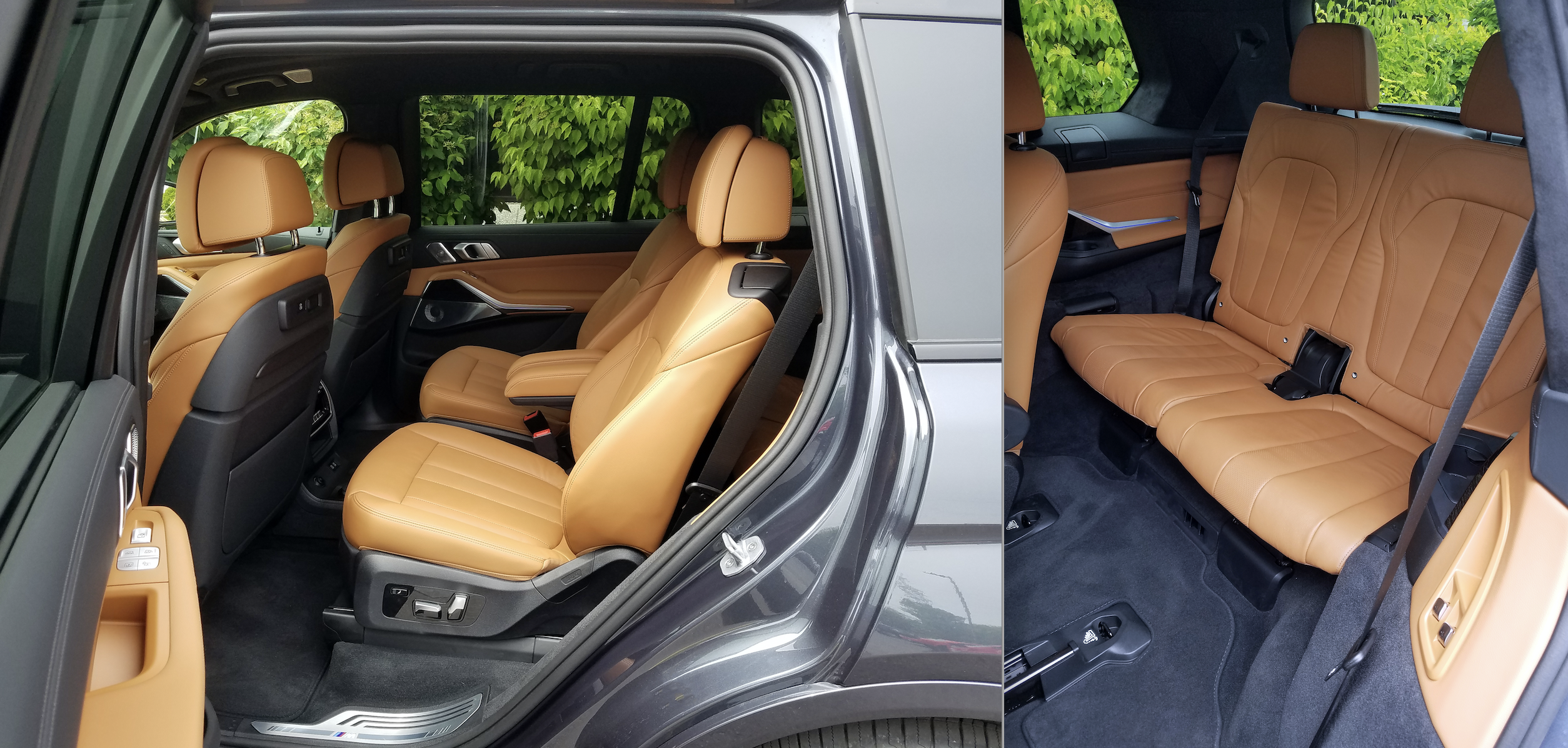
In addition to items already mentioned, significant 50i standard equipment includes a 4-zone climate system (with 5-zone optional), heated multi-contour front seats with memory function, LED headlights and fog lights, head-up display, panoramic moonroof, and 21-inch alloy wheels. Technology and safety features are blind-spot detection, lane-departure warning, front collision warning and mitigation, automatic high beams, Apple CarPlay smartphone compatibility, wireless charging, and parking assistance with surround-view cameras. Extended Traffic Jam Assist is an adaptive cruise-control system that permits hands-free driving on limited-access highways at speeds below 37 mph.
$200,000 Plus: The Most Expensive SUVs

The X7’s power tailgate is in the 2-piece style that BMW favors for its SUVs, with a large upper transom and smaller lower tailgate. Good, easy-loading cargo space becomes available as soon as the third-row seats are retracted.
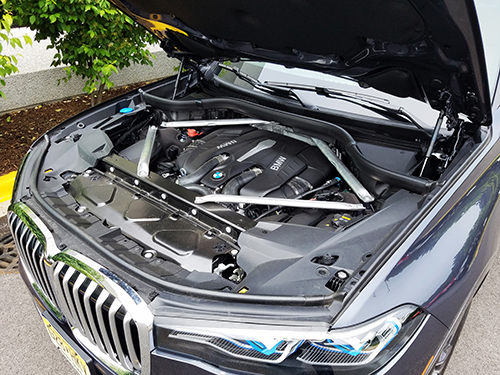
Luxuries and technologies are all well and good, but this wouldn’t be a BMW without attention being paid to performance and driving behavior. The 50i’s V8 makes a considerable 479 lb-ft of torque, and it reaches that peak in as little as 1500 rpm, so it is sharp off the line. There’s plenty of strength for highway passing and merging, and—thanks to different transmission behavior with snappier, more abrupt shifts in “Sport,” one of four selectable drive modes—the truck can feel (and sound) downright racy. Less exciting is the fuel mileage, which the EPA projects at 15 mpg in the city and 21 on the highway. In the wake of a 258.5-mile stint that was 54 percent city-style driving, this reviewer recorded 16.41 mpg, which is about in line with the EPA’s 17-mpg estimate for mixed city/highway operation.
The costliest option added to CG’s test vehicle was the $4750 Dynamic Handling Package. The package includes “Active Comfort Drive,” an electromechanical stabilization system for cornering; “Road Preview,” which uses a camera behind the rearview mirror to read the road surface ahead and make suspension adjustments via the “Dynamic Damper Control” system; and“ Integral Active Steering” that turns the rear wheels opposite to the front wheels at low speeds to tighten turning radius, and turns the rear wheels in the same direction as the fronts at higher speeds to improve vehicle stability. Ride in “Comfort” drive mode seemed a little too soft at times, with some body wallow and pitching when crossing pavement cracks and potholes. However, switching to Sport reduced this tendency. Braking response was excellent.
Extensively optioned as it was, the test X7 50i rose to $112,245. There is no penalty in room in the 40i version, and some of its standard-equipment compromises can be redeemed from the options list if you must have them, so the 6-cylinder model dangles a better value proposition. Either way, it’s clear BMW has entered the large SUV class in a big way.
Test Drive: 2019 Infiniti QX80 Limited
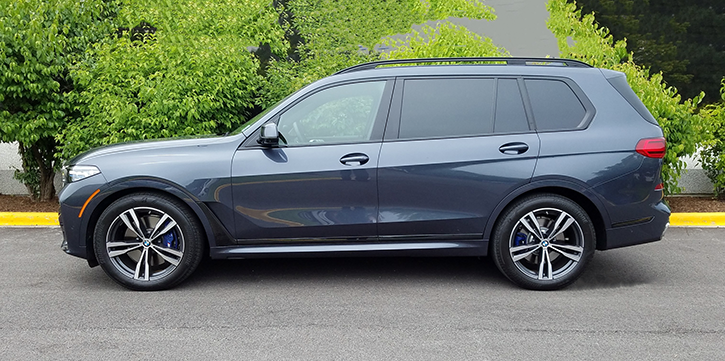
Test Drive: 2019 GMC Yukon XL Denali
2019 BMW X7


